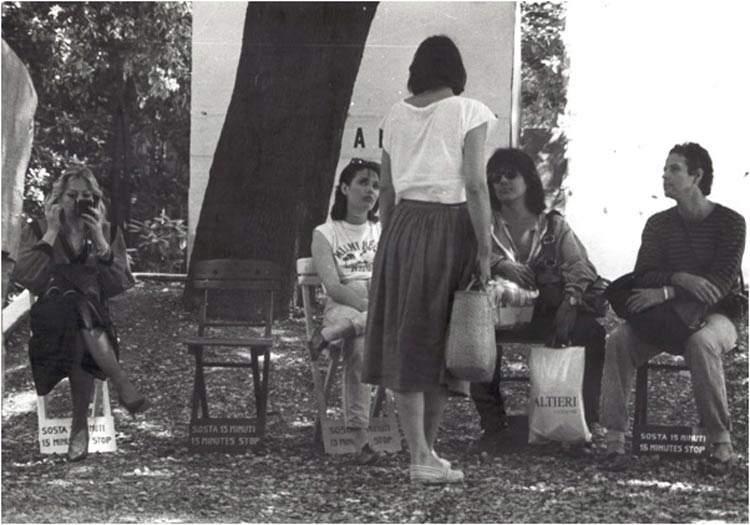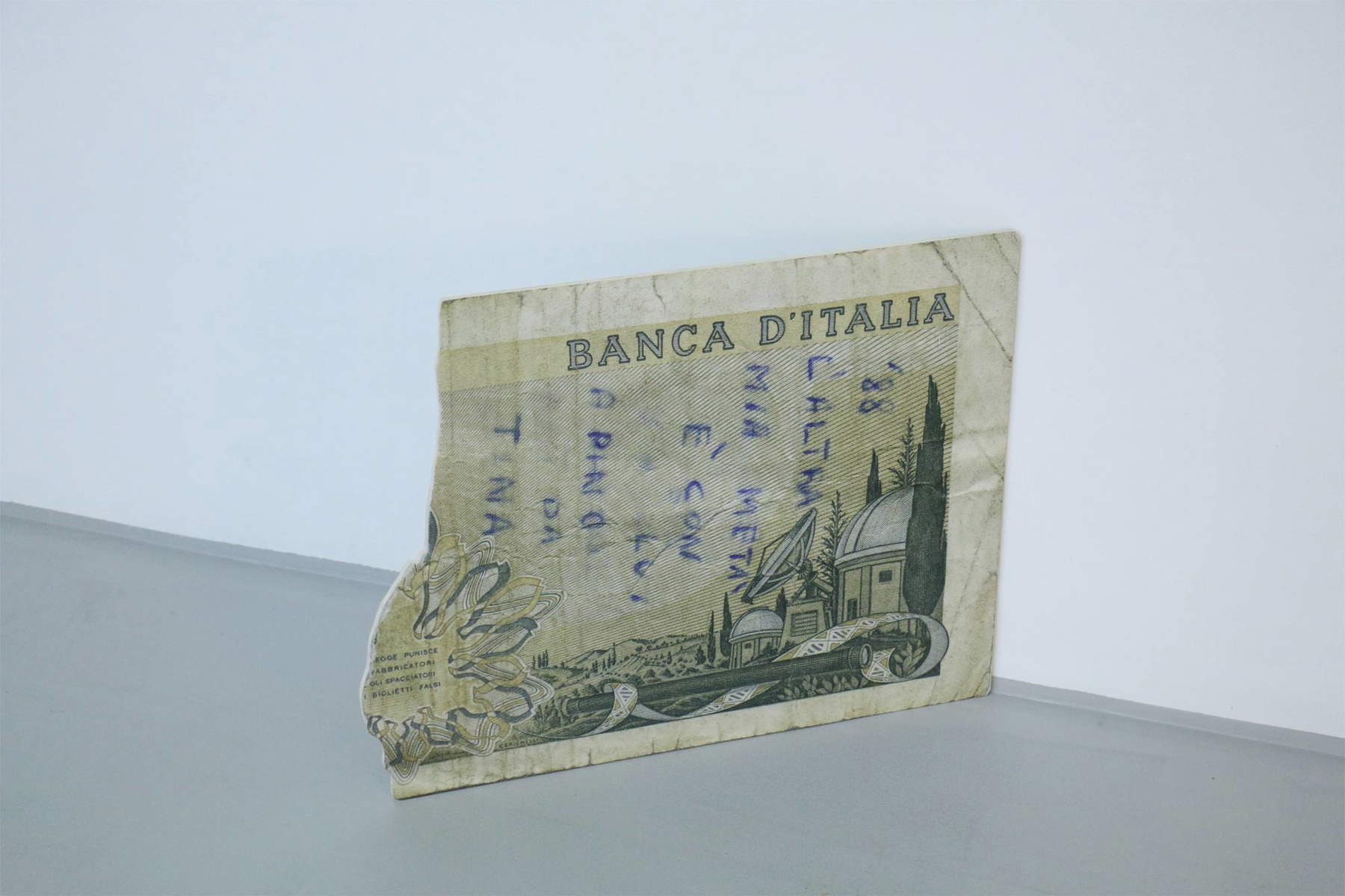From May 27 to September 18, 2021, the Inner room Open Zona Toselli diffuse art project in Siena is organizing, together with the Municipality of Siena, Ance Siena, Confindustria and the Order of Architects, the Remedy project, the first retrospective exhibition of the Piombino Group, with historical works (from 1984 to 1991, the period in which the group was active) by Salvatore Falci (Bergamo, 1950), Stefano Fontana, Pino Modica (Civitavecchia, 1952) and Cesare Pietroiusti (Rome, 1955). The Piombino Group, in its seven years of activity, proposed itself as an alternative to the postmodern trends active in Italy at the time and stands as, chronologically, the most recent group in the sense of a militant artistic fellowship formed in Italy. Moreover, the group constituted one of the earliest experiences in the field of unconscious interaction in the urban sphere: its work poses a fundamental prerequisite of those artistic practices and modes of operation that became established from the mid-1990s and later termed Relational Art.
Alongside the group’s historical works, ranging from the 1984 Venice Biennale’s sedulas to urban interactions, the public will also see recent works, installed according to a site-specific logic in the companies participating in the project. Almost 30 years after the dissolution of the artists’ association, the exhibition re-presents some of the most representative works of that experience. These so-called historical works (now definitively crystallized in a form that bears witness to an unrepeatable and irreversible transformation and no longer functioning and open to public interaction) are collected within non-deputed spaces of art, such as The companies CasaNova, Fusi&Fusi, Sali&Giorgi. Thus, the two moments of the two-stage exhibition articulation, dear to Piombino’s art theory, will be found in the same exhibition. On the one hand, the site-specific projects in progress, live experiments aimed at involving in the (potentially aesthetic) interaction a generic and unaware public, and on the other hand works that tell of an interaction that has already taken place, which has definitively transformed the apparent or not appearance of everyday objects, projecting them outside the serial configuration and re-individualizing them. And precisely this non-forgetfulness of the object, this failure to evaporate and disappear from the scene, constitutes one of the main characteristics that seem to characterize and distinguish Piombino from the Relational Art movement, a discourse more relevant than ever.
The historic exhibition of the Piombino Group in Siena in turn represents a historic choice: the first time that three of the four artists of the group (Falci-Fontana-Modica) exhibited together in a public show was precisely in the Medici fortress of Siena, in a section of the exhibition Una generazione nuovissima nell’arte italiana curated by Enrico Crispolti (August 1985), expressly created for them and titled Azione partecipata.
“Reviewed after thirty years and more,” Domenico Nardone, the group’s theorist, writes today, “these works do not appear to be covered by the patina of time; on the contrary, the vitality of the propulsive thrust that the Piombino project still shows it can exert, far beyond the conclusion of its historical experience, in defiance and in spite of everything and everyone, is something that cannot help but surprise. In the global village of accelerated and widespread communication, an experience that is almost nonexistent in the art market, systematically ousted if not ostracized from the Barnum circus of exhibitions organized and managed by official critics, ignored if not censored by the glossy and self-styled specialized press, nonetheless becomes progressively the object of growing interest on the part of new generations of historians and artists in the multiplication of theses and studies devoted to it in universities and the Academies of Fine Arts. Lateral, oblique, and antagonistic to the historia oficial popularized and propagandized and obsessively trumpeted to the four winds by the constituted Power in regime, another history takes shape and is handed down, a history ’other’ and different, the underground history. Behind the scenes of the stage lit brightly by the lights of servile criticism, where Power sets up its Fêtes Galantes, behind the shot of those stainless steel mirrors that render the portraits of a bourgeoisie plastered and immobile in the gestures and attitudes it repeats and replicates over time, always identical to themselves, from generation to generation, the subterranean history weaves and unstoppably weaves its network of relationships and synapses, germinates and grows, and progressively and with ever-increasing force presses against the surface.”I remember, yes, I remember that Piombino was a community of feelante litteram when no one was talking about that yet. I remember, yes, I remember the waning of ideologies, the Berlin Wall dismantled piece by piece and sold as a gadget, the red flag lowered from the domes of the Kremlin."
“Remedy,” the Inner Room - Open Zona Toselli coordination let us know, “through the reading of places, with a series of art installations, transforms Viale Toselli: new situations stimulate social,economic, cultural lindotto, all the more if supported by the new municipal projects of mobility and territorial reorganization that are converging on this part of the city.”
“Inner room - Open Zona Toselli develops an aspect that, in line with the strategies of our national association, involves Ance Siena Confindustria,” says President Giannetto Marchettini, “namely, Urban Regeneration. The completion of the urbanization works for internal mobility in Viale Toselli, included by the Municipality in the Urban Plan of Sustainable Mobility, will allow the redevelopment, enhancement of this area, with an important role of this project.”
“The involvement of the Order of Architects,” explains President Nicola Valente, “is supported by the sensitivity, due to the characteristics of our profession, to the initiatives that qualify the territory with the awareness of participating in the actions that call us in. These aspects make it interesting to project the art of the Piombino Group in the Artisan Village.”
The Remedy cycle includes a program of exhibitions and solo performances by members of the Piombino Group and concerts in collaboration with the Accademia Musicale Chigiana in companies in the Siena Craft Zone. Here is the program:
July 15, 2021, Stefano Fontana Short Paper Message
Carrefour - Ateneo della Danza, Piazza Maestri del Lavoro
La Sosta dellArtigiano -LOfficina, Artisan Village
Gaston Intimo Chic, Toselli Avenue
July 28, 2021, Pino Modica Recent Works
Sali&Giorgi CasaNova - Gaston Intimo Chic, Toselli Avenue
Fusi&Fusi, Artisan Village
August 18, 2021, Salvatore Falci In Hoc Signo Vinces
Craft Village exteriors
Sept. 16, 2021, Cesare Pietroiusti Communion (one-act performance)
Confartigianato Headquarters, Viale dellArtigianato.
July 15, July 28, in collaboration with Chigiana International Festival&Summer Academy, concerts by Chigiana students
San Marco Autocarrozzeria Fusi&Fusi, Craft Village
Theoretical coordination is by Dr. Romeo GiuliThe exhibition is accompanied by dartist jewelry by Salvatore Falci
 |
| Salvatore Falci, Stefano Fontana, Pino Modica, Sosta 15 minuti (1984) |
 |
| Salvatore Falci, Stefano Fontana, Pino Modica, Sosta Quindici Minuti, urban intervention with colored chairs, at the Giardini of the XLI Venice Biennale (1984) |
 |
| Pino Modica, Aesthetic Detector, urban intervention, apparatus with hidden camera from which a video is taken (1985) |
 |
| Cesare Pietroiusti, 2000 Lire The other half is with him, Photographic print on aluminum |
 |
| In Siena for the first time a retrospective exhibition on the Piombino Group |
Warning: the translation into English of the original Italian article was created using automatic tools. We undertake to review all articles, but we do not guarantee the total absence of inaccuracies in the translation due to the program. You can find the original by clicking on the ITA button. If you find any mistake,please contact us.